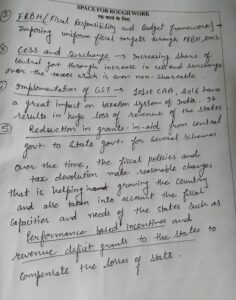The Indian Constitution, with its many clauses, embodies social justice, pluralism, and equality despite being a synthesis of many constitutions from around the world. Remark. (Answer in 250 words)
All democratic countries are governed by a Constitution. In the 1967 Golaknath case, India's Supreme Court ruled that Parliament couldn't amend fundamental rights. Adolf Hitler's transformation of Germany's Weimar Constitution from democratic to dictatorial is a notable example of altering a constitRead more
All democratic countries are governed by a Constitution. In the 1967 Golaknath case, India’s Supreme Court ruled that Parliament couldn’t amend fundamental rights. Adolf Hitler’s transformation of Germany’s Weimar Constitution from democratic to dictatorial is a notable example of altering a constitution.
In 1972, the Keshavananda Bharati case settled the debate on Parliament’s power to amend the Constitution. Keshavananda Bharati, chief priest at Sri Edneer Mutt in Kerala, challenged the Kerala Land Reforms Act of 1963, claiming it violated Article 26 on religious freedom. This case allowed the Supreme Court to define Parliament’s amendment authority.
The Court’s ruling affirmed the Constitution’s supremacy and established the “basic structure doctrine,” which prevents amendments that alter the fundamental framework of the Constitution. This doctrine was later applied in the Minerva Mills and Waman Rao cases. The 24th and 25th Amendments of 1971 aimed to nullify the Golaknath judgment.
The Keshavananda Bharati case, concluded in March 1973 by a 13-judge bench, resulted in a 7:6 decision, with Justice H.R. Khanna as the tiebreaker. Although Bharati lost, the basic structure doctrine was established. Justice A.N. Ray, who dissented, later became Chief Justice of India.
The Keshavananda Bharati case was crucial in shaping Indian constitutional law, ensuring protection against potential authoritarianism.
See less


The Indian Constitution, which came to force on 26th January, 1950, is a blend of features of Constitutions from across the globe. Constitutions of U.S.A., Ireland, U.K., Canada, Australia, Germany, erstwhile USSR, France, south Africa and Japan have been combed thoroughly, to compile the best featuRead more
The Indian Constitution, which came to force on 26th January, 1950, is a blend of features of Constitutions from across the globe. Constitutions of U.S.A., Ireland, U.K., Canada, Australia, Germany, erstwhile USSR, France, south Africa and Japan have been combed thoroughly, to compile the best features in the Indian Constitution.
The ideals of equality, justice and pluralism are secured through various Fundamental Rights (Articles 12-35) and Directive principles of state policy (Articles 36-51). Article 14 advocates equality before law, no matter one’s status in any regard. Article 15 describes discrimination on the basis of religion, race, caste, sex, or place of birth as a punishable offence. Article 16 promotes equal footing in matters of public employment. Article 17 prohibits the ancient practice of untouchability as it existed in the country thus, cementing the ideal of equality.
Articles 25-28 grant religious freedom as long as it keeps a legal and peaceful face. No restrictions posed on faith symbolise the pluralistic nature of our constitution.
Article 39, under DPSP, secures equal remuneration for equal work for both, men and women. Article 39-A, which was added through the 42nd Constitutional Amendment, 1976, makes it the state’s responsibility to assure free legal aid so that justice is ensured, to all citizens.
The very purpose of the Indian Constitution being a blend of various constitutions is, to accommodate the diversity within its citizens to facilitate peaceful coexistence.
See less